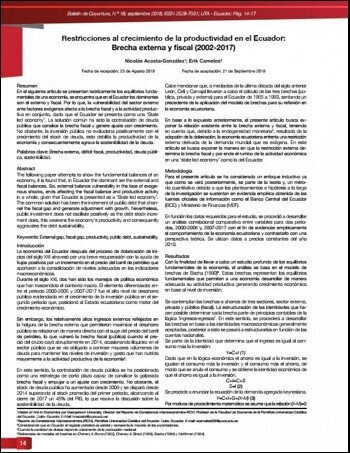Restrictions on productivity growth in Ecuador: External and fiscal gap (2002-2017)
Main Article Content
Abstract
The following paper attempts to show the fundamental balances of an economy, it is found that, in Ecuador the dominant are the external and fiscal balances. So, external balance vulnerability in the face of exogenous shocks, ends affecting the fiscal balance and productive activity in a whole, given that Ecuador is presented as a 'State led economy’. The common solution has been the increment of public debt that channel the fiscal gap and generate adjustment with growth. Nevertheless, public investment does not oscillate positively as the debt stock increment does, this weakens the economy's productivity and consequently aggravates the debt sustainability.
DOI: https://doi.org/10.31164/bcoyu.18.2018.672
URL: http://revistas.uta.edu.ec/erevista/index.php/bcoyu/article/view/672
Downloads
Article Details

This work is licensed under a Creative Commons Attribution-NonCommercial 4.0 International License.
![]()
The publications of the Boletín de Coyuntura are licensed under a Creative Commons Attribution-NonCommercial 4.0 International License (CC BY-NC 4.0). The Universidad Técnica de Ambato retains the copyright of the published works, and favors and allows the reuse of these, as long as: the authorship and original source of publication is cited, and they are not used for commercial or onerous purposes. The intellectual property of the published articles belongs to the authors.
References
Argandoña, A., & Carrasquero, C. (2006). Análisis de la sostenibilidad de la deuda pública. Estrategia Financiera N°232.
Bacha, E. (1990). A three-gap model of foreing trasnfers and the GDP growth rate in developing countries. Journal of Development Economics, 279-296.
Bacha, E. L. (1984). Growth with limited supplies of foreign exchange: A reappraisal of the two-gap model. Economic structure and performance, 263-280.
Chenery, & Bruno. (1962). Development alteratives in a open economy. Economic Journal 57, 79-103.
Chenery, Hllis, & Strout. (1966). Foreing assistance and economic devel-opment. American Economics Review 56, 679-733.
Christiansen, L., Prati, A., Ricci, L. A., & Tressel, T. (2009). External Bal-ance in Low-income counties. NBER, 265-322.
Edwards, S. (1995). Why are saving rates so different across countries?. Cambridge Working Paper 5097.
Eyzaguirre, N. (1989). Ahorro e inversión bajo restricción externa y fiscal. El caso de Chile 1982-87. Santiago: ECLA.
Ghosh, A. R., & Ostry, J. D. (1994). Export Instability and the External Balance in Developing Countries. Staff paper IMF 41, 214-235.
León, P., Celi, E., & Carvajal, F. (s.f.). El modelo de tres brechas una perspectiva empirica para el caso ecuatoriano 1965-1993.
McKinnon, R. I. (1964). Foreign exchange constraints in economic de-velopment and efficient aid allocation. The Economic Journal 74, 388-409.
Romaguera, P., & Contreras, D. (1992). Restricciones al crecimiento: aplicación de un modelo de brechas a la economía chilena. Colección Estudios CIEPLAN, 145-182.


